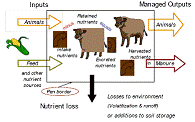Biological Systems Engineering, Department of

Department of Agricultural and Biological Systems Engineering: Presentations and White Papers
Date of this Version
5-18-2005
Document Type
Article
Abstract
Across the United States and abroad, innovative producers, processors, trade organizations and others in the agricultural sector are exploring the promise of Environmental Management Systems (EMS) to improve their environmental and business performance. An Environmental Management System or EMS helps farmers develop their own, personal strategies for reducing environmental risk on their operations by integrating environmental management considerations into production management decisions. It is a voluntary, flexible approach and is based on a producer's own sense of how best to manage an operation.
Partnerships for Livestock Environmental Management Systems is a 4-year project to explore the potential of livestock Environmental Management Systems to help prevent non-point pollution and resolve community and regulatory concerns. The project goal is to develop and evaluate environmental management tools and procedures with which livestock producers can address local priority water and air quality issues. Using these tools, cooperators from nine states developed EMS’s with more than 100 dairy, beef, and poultry producers. Surveys were used to assess the impacts of EMS development on the producers and interviews indicated the farmer’s perceptions of the EMS’s on their operations. Each of the nine states (Iowa, Montana, Texas, Idaho, New York, Wisconsin, Georgia, Pennsylvania and Virginia) approached differently the educational task of helping farmers recognize the value of an EMS and embrace its development and implementation. The evaluation seeks to tease out which educational approaches and strategies worked best by studying both the educators’ practices and the farmers’ responses and perceptions. Preliminary results indicate that EMS can benefit some operations and that larger operations view EMS’s as a method of maintaining compliance, improving management, and demonstrating their environmental stewardship.


Comments
Paper presented at Livestock Environment VII, Proceedings of the Seventh International Symposium, 18-20 May 2005 (Beijing, China). Publication Date 18 May 2005, ASAE Publication Number 701P0205. Ed. T. Brown-Brandl. Copyright 2005 American Society of Agricultural Engineers, St. Joseph, Michigan USA. Copyright © 2005 L. M. Risse, R. Koelsch, W. Bland, E. Bird, and T. Bass.